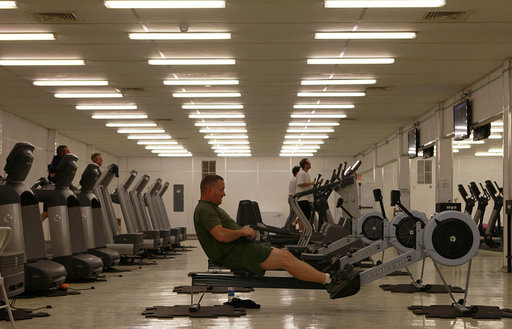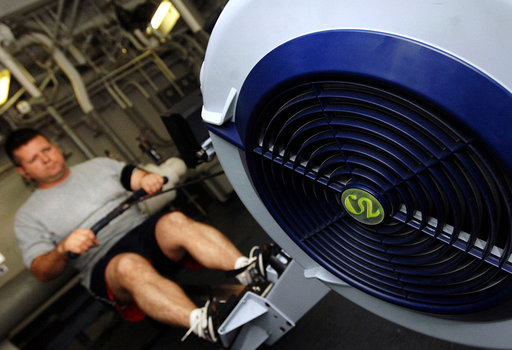Enhance your health with free online physiotherapy exercise lessons and videos about various disease and health condition
Indoor Rowing Machines
Indoor rowing machines are machines that are used to prepare athletes for racing against others on lakes, rivers or oceans. The sport can be both recreational, focusing on learning the required techniques, or competitive where over-all fitness plays a large role. The rowing machine works and strengths multiple muscle groups and is one of the leading seated cardiovascular exercise.
Rowing machines helps to expand lungs in an excellent way. They enhance stamina, resistance and strength, all at the same time. As a result, lungs capacity gets bigger and better. At the same time, regular training make use of the heart. With workout, the blood flow boosts which enhances heart strength.
Indoor rowing machines not only works on upper side of the body, as most people believe, but also they work the lower side of the body. To be more specific. As you row, you will work your back, shoulders, arms and abs. But when you slide back, you will make use of your hips, your legs, your butt, and your torso too!
Muscles worked out with regular rowing
Pectoralis Major
The pectoralis major is a thick, fan-shaped muscle situated at the chest of the body. It is primarily responsible for movement of the shoulder joint. The 1st action, is flexion of the humerus, 2nd it adducts the humerus, 3rd it rotates the humerus medially, and finally it aids in deep respiration.
Cardiac Muscles
Cardiac muscle is a type of involuntary striated muscle found in the walls in foundation of the heart. Unlike skeletal muscle, cardiac muscle requires extracellular calcium ions for contracture to occur. They aid the heart by circulation the blood throughout the body to bring nutrients and oxygen to the individual muscles.
Biceps
The biceps brachii comes from a Latin phrase meaning “ two- headed muscles of the arm” in reference to the fact that the muscle consists of two bundles of muscles sharing a common insertion point near the elbow joint. The most important function of the biceps is to supinate the forearm and flex the elbow.
Abdominal Muscles
The abdominal muscles have different important functions: they provide movement and support to the upper body and assist in the breathing process. Also, these muscles serve as protections for the inner organs. Furthermore, together with the back muscles, the provide postural support and are important in defining the form.
Quadriceps Femoris
Quadriceps Femoris is a large muscle group that includes the four prevailing muscles on the front the thigh. It is the strongest and leanest muscle in the human body and is responsible for extending the knee joint, flexing the hip, and stabilizing the patella and knee joint.
Latissimus Dorsi
Latitissimus Dorsi meaning “ broadest muscle of the back” is the larger, flat muscle on the back, posterior to the arm. This muscle helps in the extension, adduction, horizontal abduction, and internal rotation of the shoulder joint. It also plays a role in the extension and lateral flexion of the lumbar spine.
Gluteus Medius
The gluteus medius is the top most of the three gluteal muscles, and is broad, thick, and situated on the outer surface of the pelvis. This muscle plays a role in the abduction of the thigh and the internal and external rotation of the thigh.
Additionally, it supports the pelvis and prevents it from dropping to the opposite side while is an unstable position.
Triceps Surae
The triceps surae is the pair of the muscles located at the calf nearest the midline. These muscles insert into the calcaneus and from what is commonly known as the calf muscle. These two muscles work together to primarily stabilize the ankle and help while walking, running and jumping.
Advantages of Indoor Rowing Machine

- Total Body Workout
- Greater Flexibility
- Superior Conditioning
- Burns Calories
- Lifelong Pursuit
- Impact-Free
- Time Efficient
- It's FUN!
If you take out 700 calories in 1 of the 24 hours, then you have 23 hours (in fact it's less, if you take out the 8 hours of sleep) to kill the remaining +1000 calories.
The Best Type Of Indoor Rowing Machine
1) Magnetic Resistance Rowing Machine
Indoor rowing machines kills around 700 calories per hour of training. If you take in count that most people intake approximately 2000 calories per day, that's a lot!
Advantages
- Noiseless
- Smooth operation
- Customizable
- Small
- Almost no maintainance required
2) Hydraulic Resistance Rowing Machine

Advantages
- Smallest of all types
- Among the cheapest
- High usability
Disadvantages
- Maintenance required
- Operation not as smooth as magnetic
3) Water Resistance Rowing Machine
Advantages
- Real rowing experience
- Smooth operation
Disadvantages
- Expensive
- Big
- Not easy to store
4) Air Resistance Rowing Machine
Advantages
- Great control
- Makes you work atyour own pace
- Great for tall people
Disadvantages
- Noisy
- Big
Recent Articles
|
Author's Pick
Rating: 4.4 Votes: 252 |
References
- Fenwick CM, Brown SH, McGill SM. Comparison of different rowing exercises: trunk muscle activation and lumbar spine motion, load, and stiffness. J Strength Cond Res. 2009 Aug;23(5):1408-17.
- Ingham SA, Pringle JS, Hardman SL, Fudge BW, Richmond VL. Comparison of step-wise and ramp-wise incremental rowing exercise tests and 2000-m rowing ergometer performance. Int J Sports Physiol Perform. 2013 Mar;8(2):123-9. Epub 2012 Jul 31.
- Hagerman FC. Applied physiology of rowing. Sports Med. 1984 Jul-Aug;1(4):303-26. [PubMed]
- Krainski F, Hastings JL, Heinicke K, Romain N, Pacini EL, Snell PG, Wyrick P, Palmer MD, Haller RG, Levine BD. The effect of rowing ergometry and resistive exercise on skeletal muscle structure and function during bed rest. J Appl Physiol (1985). 2014 Jun 15;116(12):1569-81. doi: 10.1152/japplphysiol.00803.2013. Epub 2014 May 1.
Return from Indoor Rowing Machines to Home Page

